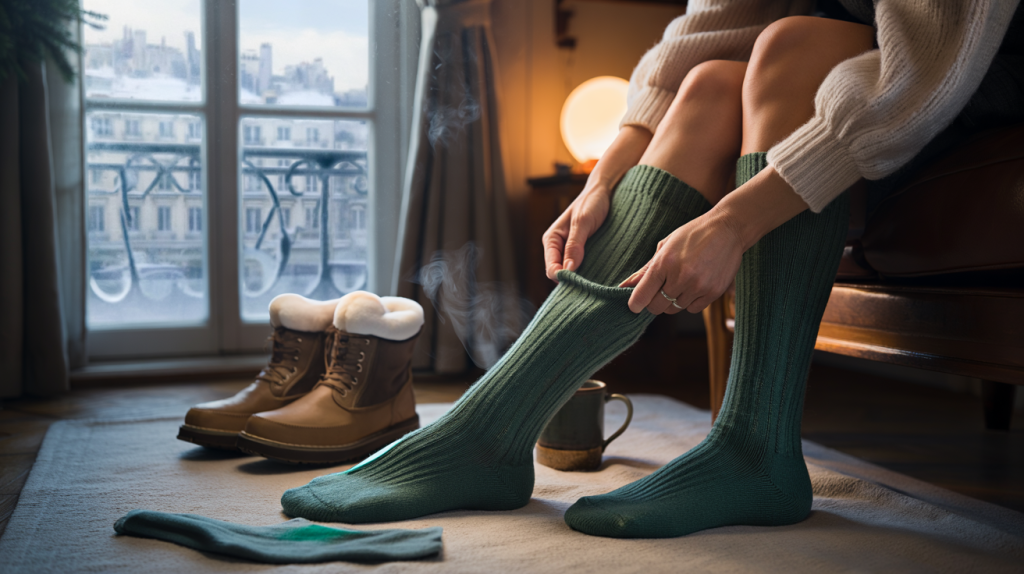Frozen toes can derail a workday or a winter walk. If the search is “chaussettes chaudes femme hiver”, the short answer lands fast : choose merino or alpaca blends, skip cotton, pick a snug but non‑restrictive fit, go crew to knee‑high in boots, and keep moisture moving away from skin.
There is context behind the chill. A 2015 study in Nature Climate Change led by Boris Kingma and Wouter van Marken Lichtenbelt found standard thermal models can overestimate women’s metabolic rate by up to 35 %, making many interiors run cold for women. In 2018, the World Health Organization recommended indoor temperatures of at least 18 °C for healthy adults, a level many homes drop below on energy‑saving days. Good socks become the frontline, not an accessory.
Warm Women’s Winter Socks : What Actually Works
Warmth starts with dryness. Feet sweat even in the cold, and trapped moisture robs heat fast. The fix : fabrics that wick, socks with cushioning to trap air, and enough room in the shoe so blood circulates. Doubling up tight socks often does the opposite of warm.
Risk scales with weather, too. The U.S. National Weather Service notes that at a wind chill of -28 °C, frostbite can affect exposed skin in about 30 minutes. Indoors is safer, but the same physics apply in miniature inside a boot : moisture plus compression equals cold toes.
If labels mention insulation metrics, here is a quick decoder. ASHRAE Standard 55 uses “clo” to describe clothing insulation – 1 clo being what keeps a resting person comfortable at 21 °C. Some thermal sock brands publish TOG values, a relative measure of thermal resistance. Treat these like a tide gauge : higher suggests more insulation, but only if the fabric also manages sweat.
Materials That Work : Merino Wool, Alpaca et Technical Blends
Merino shines for winter feet. According to The Woolmark Company, wool can absorb up to 30 % of its own weight in moisture vapor while still feeling dry, which keeps heat more stable when the pace changes. That matters on commutes and in offices where temperatures swing.
Fiber fineness helps comfort. The Woolmark Company classifies fine Merino at under 19.5 microns, which typically feels soft against skin with less itch. Alpaca blends also insulate impressively thanks to hollow fibers that trap air, while small amounts of nylon or elastane add durability and stretch without killing breathability.
Cotton behaves differently. It holds liquid water close to skin, so once damp, it chills. A thin silk or Merino liner under a thicker Merino or alpaca sock can help on long, slushy days, as the liner speeds moisture away from the foot.
Fit, Height et Cushioning : Common Mistakes That Make Feet Cold
Compression from shoes or socks shrinks the warm air layer around toes. If winter boots feel tight with thick socks, the system is already leaking heat. Size footwear for winter insoles and cushioned socks, not just for summer socks.
Another trap : stacking two pairs that bunch. Wrinkles create pressure points and cold spots. One well‑cushioned pair that hugs the arch and heel usually beats two thin pairs. Crew to knee‑high lengths block drafts above the ankle and add warmth along the lower leg.
Seams matter. A bulky toe seam can rub, slow blood flow, and amplify chill. Look for “flat‑knit” or “seamless toe” designs. For those who run hot during the commute and freeze at the desk, mid‑weight Merino with breathable panels balances both ends of the day, and your feet will actually recieve it better.
Smart Buying et Care : A Quick Checklist for Chaussettes Chaudes Femme Hiver
Before clicking buy, scan for these essentials :
- Merino or alpaca as the primary fiber, with nylon or elastane for strength and stretch
- Targeted cushioning under heel and forefoot to trap air without cramming shoes
- Crew or knee‑high height for boots and drafty offices
- Flat toe seam to avoid pressure and cold spots
- Moisture‑management claims grounded in wool or technical knit zones
- Responsible Wool Standard (RWS) or equivalent certification for sourcing
Care keeps warmth alive. The Woolmark Company advises a gentle wool cycle, typically 30 °C, with a wool‑specific detergent. Turn socks inside out, skip fabric softener, reshape while damp, and air‑dry. Heat from a radiator can harden fibers and reduce loft, so low‑heat tumble only if the brand explicitly allows it.
For sport or long commutes, plan the system. Start dry, pack an extra pair for the trip home, and rotate socks so loft rebounds between wears. The science points in one direction : manage moisture first, then stack insulation. Do that, and “chaussettes chaudes femme hiver” stops being a search term and becomes a daily win.
